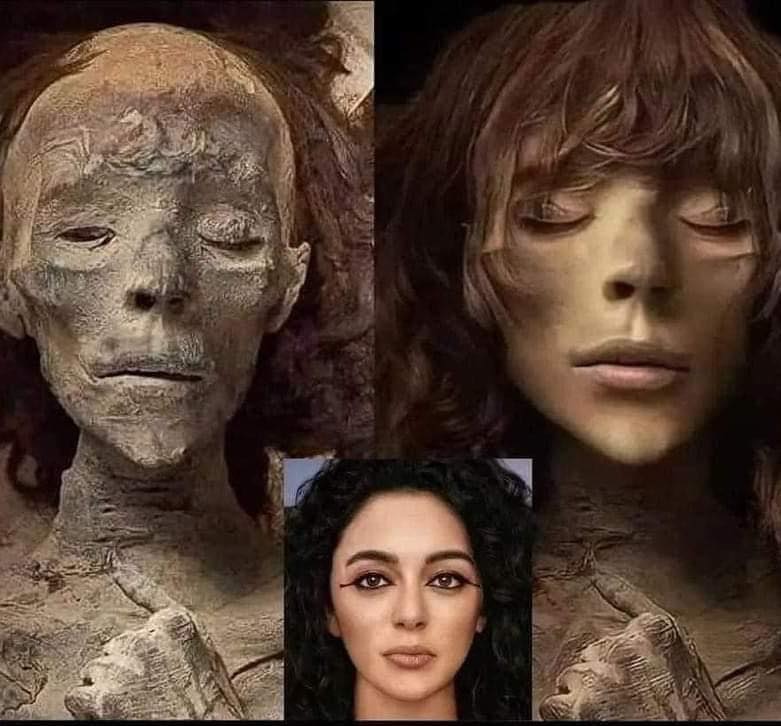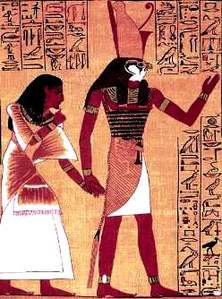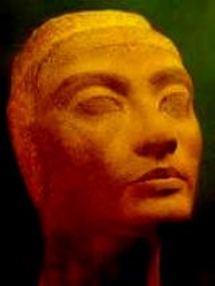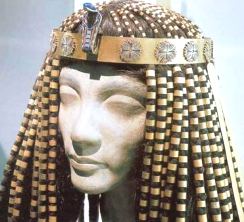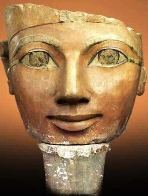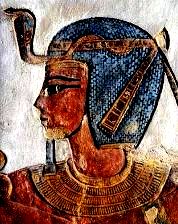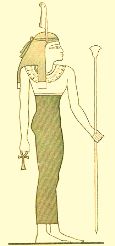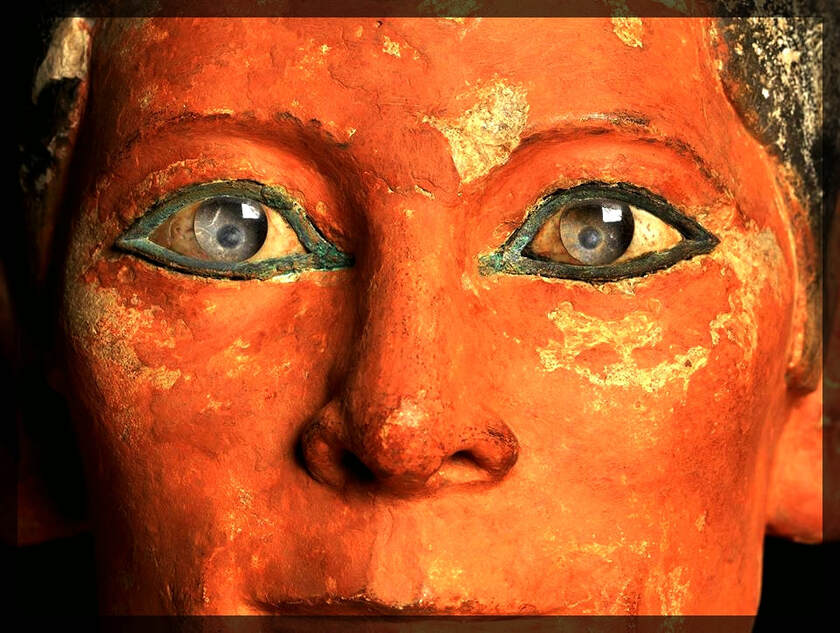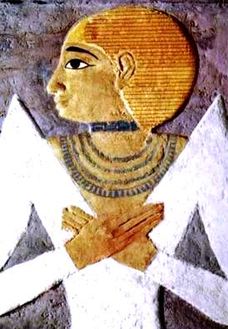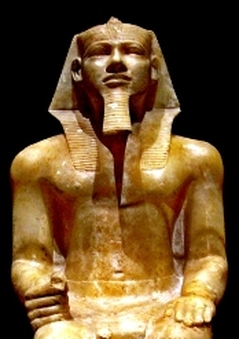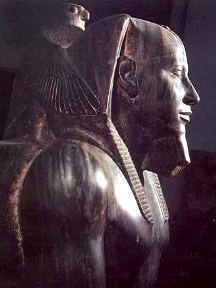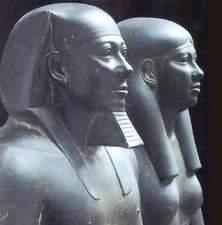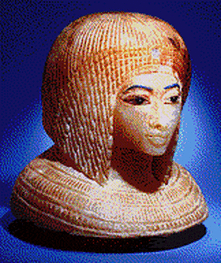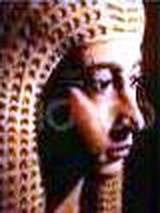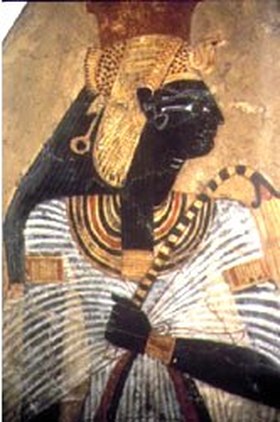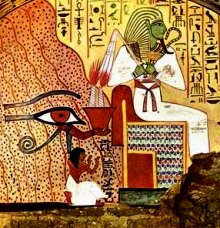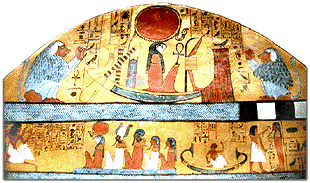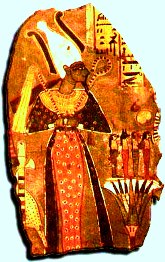VOLUME ONE
CHAPTER TEN
The Disciples of Horus
|
The land we now call Egypt was colonized...and was originally peopled by fair Celts from the shores of Britain. This was the Exodus of the Aryans, some of whom returned later to their primeval homes - Comyns Beaumont (Riddle of Pre-Historic Britain)
Classical archaeologists are in agreement that ancient migrations did take place in prehistoric times, although they often tend to be rather hazy about the dates and the countries involved - Ralph Ellis (Jesus: Last of the Pharaohs) |
We learn from official sources that the symbols found throughout Western countries - on flags and state regalia, etc - come from spurious migrating "Semitic" tribes. We are told that the symbolism originates with these tribes and goes back to the dawn of time.
We also know what "dawn of time" means officially. We know it refers to the period between 7,000 and 11,000 years BC. However, as we are now beginning to realize, these dates do not mark the beginnings of mankind's cultural and technical history.
We also know what "dawn of time" means officially. We know it refers to the period between 7,000 and 11,000 years BC. However, as we are now beginning to realize, these dates do not mark the beginnings of mankind's cultural and technical history.
|
Herodotus himself is on record as having been told by contemporary Egyptian priests that their written records went back no less than 12,000 years. Eusebius, the early Christian bishop of Alexandria, calculated Manetho's recorded history as taking Egypt's civilization back 35,525 years...Other records (both cultural and historical) were far more ancient still - John Gordon (Egypt: Child of Atlantis)
|
Although equally magnificent temples and megaliths exist in Ireland, Scandinavia, North America and Mexico; although entire lost cities are found beneath the oceans, and though the vast majority of words, place and personal names in the Bible are of Irish origin, we rather live with mysteries and unsolvable conundrums than face the truth. In almost every case where a major site exists, or where a great civilization existed, we find the same refrain from the modern inhabitants. Either we are told that "godlike strangers" erected the sites, or that technically superior semi-divine ancestors, of whom we now suspiciously find no trace, did it. Archaeologists refuse to explain who these mysterious ancestors were. The world over, legends affirm that indigenous forebears were not the builders, astronomers and healers. Investigators habitually look to every country except Ireland for their answers. It is almost comical to say that we can be certain that Ireland played a seminal role merely because the laws of exclusion are in its favor. All other countries have been studied and can be struck off as originators of civilization. So dare we now, at long last, face the truth that has lain in plain sight for so long? Dare we examine the evidence for the Irish origins of civilization and have done with the damnable conundrums?
|
...the ancient Egyptians were fully aware of the 25,920-year cycle of the precession of the equinoxes. The idea, however, that a nomadic group of hunter-gatherers about 5,000 to 6,000 years ago should suddenly within the space of a few hundred years (or even a millennium), from merely watching the night sky but without using any instrumentation, be able to quickly develop the requisite mathematical and scientific knowledge to verify such a hypothesis is patently ludicrous - John Gordon (Egypt: Child of Atlantis)
|
One of the most important finds within the land of Egypt occurred when Egyptologist and archaeologist Professor Walter B. Emery (1903-1971) was excavating tombs at the necropolis of Saqqara, one of the oldest cities in the land. Professor Emery discovered the remains of men with blond hair and fair complexions. These individuals were revered by the Egyptians as a gifted elite. Vittorio Di Cesare and Adriano Forgione write about Emery's enigmatic discoveries in their article Malta: Skulls of the Mother Goddess:
|
...the famous Egyptologist, author of "Archaic Egypt"...discovered the remains of individuals who lived in the pre-dynastic epoch. These presented a dolichocephalous skull, larger than that of the local ethnic group, fair hair and a taller, heavier build. Emery declared that this stock wasn't indigenous to Egypt but had performed an important sacerdotal and governmental role in this country. This race kept its distance from the common people, blending only with the aristocratic classes and the scholar associated them with the Shemsu Hor, the "disciples of Horus"...The Shemsu Hor are recognized as the dominant sacerdotal caste in pre-dynastic Egypt (until approximately 3000 B.C.), being mentioned in the Turin papyrus and the list of the kings of Abydos
|
Professor Emery wrote of his finds in Archaic Egypt: Culture and Civilization in Egypt Five Thousand Years Ago:
|
Towards the end of the IV millennium B.C. the people known as the Disciples of Horus appear as a highly dominant aristocracy that governed entire Egypt. The theory of the existence of this race is supported by the discovery in the pre-dynastic tombs, in the northern part of Higher Egypt, of the anatomical remains of individuals with bigger skulls and builds than the native population, with so much difference to exclude any hypothetical common racial strain. The fusion of the two races must have come about in ages that concurred, more or less, with the unification of the two Egyptian Kingdoms...The racial origin of these invaders is not known and the route they took in their penetration of Egypt is equally obscure
...we find that at the dawn of the historic period Egypt was divided into the two rival kingdoms of the North and the South, both ruled by a royal house and aristocracy of the same race and both known traditionally as the "Followers of Horus" - the demigods of Manetho's history |
According to the ancient so-called Building Texts found at the temple of Edfu in Egypt, the Shemsu Hor or Disciples of Horus were a race of highly endowed sages who dwelt on ten prediluvian islands. One of their elders was Thoth, known to the Greeks as Hermes and Romans as Mercury:
|
Great were my people in the ancient days, great beyond the conception of the little people now around me; knowing the wisdom of old, seeking far within the heart of infinity knowledge that belonged to Earth's youth. Wise were we with the wisdom of the Children of Light who dwelt among us. Strong were we with the power drawn from the eternal fire. And of all these, greatest among the children of men was my father, Thoth, keeper of the great temple, link between the Children of Light who dwelt within the temple and the races of men who inhabited the ten islands
|
The term shemsu derives, most probably, from Akkadian shamash, meaning "serpent." The word is similar to Irish Shamus or Seamus and English James. We believe the term Hor - for Horus the falcon or hawk-headed god of the sun - represented the Ari or Aryans. The letter "H" was often used in the same way as "The" or "Le" in French. Therefore, Har or Harri was "The Ari." As a symbol, the hawk primarily signified spiritual status. (The name Harris or Harrison, from har, meant "hawk" or "Son of the Hawk").
Ralph Ellis has found evidence supporting the idea that the Giza Plateau and its three Pyramids were perpetually protected by a special guard known as the Horites. These Horites, although disparaged in the bible, are believed to be associated with the mysterious city of Petra located near Mount Seir. Petra dates from a relatively late period but was probably built upon a more ancient site. Nearby are sophisticated irrigation systems and a strange serpent mound identical to those found in France and Britain. There can be little doubt that the Horites were descended from the ancient Shemsu Hor, the Disciples of Horus.
Ralph Ellis has found evidence supporting the idea that the Giza Plateau and its three Pyramids were perpetually protected by a special guard known as the Horites. These Horites, although disparaged in the bible, are believed to be associated with the mysterious city of Petra located near Mount Seir. Petra dates from a relatively late period but was probably built upon a more ancient site. Nearby are sophisticated irrigation systems and a strange serpent mound identical to those found in France and Britain. There can be little doubt that the Horites were descended from the ancient Shemsu Hor, the Disciples of Horus.
|
|
There is a statement that they had worked out all their astronomy for 40,000 years before they gave it to the rest of the world, also a statement on parchment found under the corner stone of one of these temples in the Great Foundation in Dendera, in the 4th Dynasty, that "the Great Pyramid was built by the followers of Horus," and these Stellar Cult people were the followers of Horus, just as the Christians are the followers of Christ; indeed, the traditional history is identical almost in every particular, including the Crucifixion - Albert Churchward
|
As said, the root har or hor refers to Horus and the sun. Ellis maintains that this mysterious sect of specially appointed guards was despised by the Hyksos people who were none other than the Israelites of the Bible. He also maintains that one of the ancient names for Great Pyramid was Seir, a word connoting the West. If Ellis' translations are correct, as we believe them to be, could not Mt. Horeb of the Bible refer to the Pyramids rather than to some ill-defined and spuriously remote location? Was the Pyramid the mountain of light or, more correctly, mountain of the men of light?
In the year 1907, the Egyptian government decided to raise the level of the great Aswan Dam, in Southern Egypt, by seven meters. The project meant the destruction by flooding of acres of land containing many burial grounds and tombs. A hurried examination of the bodies from some Nubian tombs was made by Sir Grafton Elliot Smith who soon discovered, to his amazement, that the skulls and bones of the bodies under examination were different from those of the inhabitants of Nubia and Egypt, even though there were Egyptian characteristics to the physiognomy. In his book The Royal Mummies, published in 1912, Smith wrote of his strange alien finds:
|
The alien people present many striking features of contrast which sharply differentiate them from the population of Egypt and Nubia. In height they do not differ in any marked degree, but their crania are shorter and considerably broader than those of the indigenous people. The nose is much narrower, more prominent and high-bridged than that of the Egyptian or Nubian, and in comparison with the latter, the nasal spine is much more prominent
Nobody knows just who these blue-eyed, fair-skinned people were, or even where they came from...Anthropologically, they were termed Caucasians - Gerald O'Farrell (The Tutankhamun Deception) These people, Elliot Smith concluded, were more than intelligent enough to accomplish the amazing building feats that the modern world marvels at on the banks of the Nile - ibid Enough exists to show that the Nordic gods were the same as the gods of the Levant. The gardens, halls, warfare, altars, sacrifices, marriage and family life were the same - Anonymous (The Priesthood of the Illes) |
|
Queen Nefertiti of the 18th Dynasty. Her remains or those of a daughter were interred in County Kerry, Ireland.
|
We believe the decision to flood the sacred Nubian plains of the Northern Sudan was a ploy to conceal the burial grounds of the Western peoples who had influenced Egyptian culture. In ancient times Nubia was an independent region considered sacred by the Egyptians who thought of it as the realm of the gods. The Nile flowed down through the mountains of Nubia and so anyone buried in that area, by request or by tradition, were very esteemed.
The Caucasian features described by Sir Elliot Smith are to be seen on the face of Queen Nefertiti, her sister Mutnodjmet (wife of Pharaoh Heremheb), and daughter Meritaten (Scota). Indeed, there is little doubt in my mind that Nefertiti and her family were of Western ancestry. This explains why Scota, her eldest daughter, traveled to Ireland by way of Spain after the fall of Akhenaton's corrupt dynasty and why her grave was found, not in Egypt, but in Ireland's County Kerry. |
|
When modern academics composed reference books about early Egyptian history, they scrupulously avoided mention of the impressive body of ancient evidence attesting to the celestial rulers of predynastic Egypt - Tony Bushby (The Secret in the Bible)
The twentieth prayer of the 141st chapter of the ancient Egyptian Book of the Dead, is dedicated "to the Goddess greatly beloved, with red hair" - E. A. W. Budge (The Book of the Dead) The predynastic Egyptians, that is to say, that stratum of them which was indigenous to North Africa, belonged to a white or light-skinned race with fair hair, who in many particulars resembled the Libyans, who in later historical times lived very near the western bank of the Nile - E. A. W. Budge (Egypt in the Neolithic and Archaic Periods) Among the ancient crania from the Thebaid in the collection in the Department of Human Anatomy at Oxford, there are specimens which must unhesitatingly be considered to be those of Nordic type - L. H. Dudley Buxton (The Peoples of Asia) Ancient Egypt, for instance, was essentially a penetration of Caucasoid racial elements into Africa - Robert Gayre (Miscellaneous Racial Studies) The mummy was mostly unwrapped and on its back. Strands of reddish-blond hair lay on the floor beneath the bald head - Donald P. Ryan (description of find, by excavator of the tomb of Queen Hatshepsut) There was a queen Nitocris, braver than all the men of her time, the most beautiful of all the women, blond-haired with rosy cheeks. By her, it is said, the third pyramid was reared, with the aspect of a mountain - Manetho (third century Greco-Egyptian historian's description of 6th Dynasty queen Nitocris) According to the Graeco-Roman authors Pliny the Elder, Strabo and Diodorus Siculus, the Third Pyramid was built by a woman named Rhodopis. When translated from the original Greek, her name means "rosy-cheeked" - Mary Sutherland |
LEFT: The face of royal personage Nofret, from a statue discovered in 1871,
dating from the early Fourth Dynasty (2575-2467 BC). RIGHT: Egyptian woman
with distinctly Caucasian features. Images of even earlier white, bearded men have
been discovered in nearby Libya which like Egypt was once lush and fertile.
dating from the early Fourth Dynasty (2575-2467 BC). RIGHT: Egyptian woman
with distinctly Caucasian features. Images of even earlier white, bearded men have
been discovered in nearby Libya which like Egypt was once lush and fertile.
The first pharaoh of the first dynasty of Egypt - and founder of the great city of Memphis - King Menes, is buried in Northern Ireland. Also known as Aha Men, and Hor Aha ("Fighting Hawk"), Menes was most likely a prestigious member of Egypt’s first civilization, the remnants of which were discovered by Professor Walter Emery, and founded by the Disciples of Horus the sun god. In one ancient text, from his empty "tomb" discovered by Sir Flinders Petrie at Abydos in 1900, Menes is referred to as "King Manash...of the Sun Hawk Race."
It is not surprising, therefore, that he should have wished to travel to Ireland, the original homeland of his ancestors.
It is not surprising, therefore, that he should have wished to travel to Ireland, the original homeland of his ancestors.
|
Most pathetically tragic of all perhaps is the discovery that the hitherto unread long record inscribed on the great Ebony Label found in the "tomb" of Menes at Abydos in Upper Egypt, and written in the Sumerian script and language of his time, narrates in graphic and circumstantial detail how this great admiral and "world emperor" in his old age on "a voyage of exploration with his fleet" made the complete course to "The Furthest West Sunset Land in the Western Ocean" and there met his tragic death; and it states that his "tomb" in Egypt remained empty, and was merely a cenotaph...And the place-name of the island in the Far Western Ocean, which appears to read "Urani" suggests the place of his death and real tomb as "Erin" or Ireland - L. A. Waddell (Makers of Civilization in Race and History, 1929)
The King Manash...of the Sunset (or Upper or Western) Waters and of their Lands and Oceans, The Ruler...of the Sun Hawk race, The Pharaoh, the deceased, the Commander-in-Chief of Ships....made the complete course to the End of the Sunset Land, going in ships. He completed the inspection of the Western Lands. He built there and holding (or possession) in Urani Land. At the Lake of the Peak, Fate pierced him by a hornet (or wasp)...This bored tablet set up of hanging wood is dedicated to his memory - (From the Funerary Label of King Menes. Translated by L. A. Waddell) |
The final resting place of Menes was discovered by Professor Waddell at Knockmany (Knock Menes) in the southern part of County Tyrone not far from Lough Erne. Inscriptions found on boulder stones at the site were in Sumerian script identical to that found at Menes' empty Egyptian tomb site. Professor Waddell wrote of his unique and momentous finds:
|
In particular the photograph of one of the stones contains the same monogram of the name "Urani," and is written by the same signs as on the ebony label, but on a larger scale; and the realistic pictograph of the animal which caused the death of Menes in Urani represented it as a hornet - (Makers of Civilization in Race and History)
...I have demonstrated elsewhere that representations of this "End of the Sunset Land" occur in Ireland, engraved on prehistoric cup-marked stones at New Grange on the Boyne River, near Drogheda, which are essentially replicas of the same pictograms as in the Early Sumerian and Hittite sacred seals - L. A. Waddell (Egyptian Civilization: Its Sumerian Origins and true Chronology) |
LEFT: Queen Hatshepsut of the 18th Dynasty. RIGHT: Rameses III of the 20th Dynasty.
King Menes of Sumeria and Egypt is referred to in the Hindu Puranas as Asa Manj - "the Far Shooter," a title that reminds us of Old Testament Saul and David, and of Irish sun god Lugh," wielder of the great lance and entitled "the Long Arm. Asa meant "strong" or "valiant." In the Hindu Mahabharata Menes is Manasyu, whose title was Prabhu.
This term comes from prahu, parahu or paraa - the possible origin of pharaoh. The Hindi word meant "chief" or "father." Menes' identification with the hawk god Horus is suggestive since Horus was often referred to as the "blue-eyed" god.
Egyptian queen Tea Tephi lies near Tara, a location some believe to be named after her. The name is believed to derive from Temair or Temor meaning "mound of Tea." However, it probably derives from T-Ari, after Ari or Eri, supreme goddess of the pre-Celtic Druids. Mummified Barbary Apes were discovered at Navan in Ireland, and entries concerning places in Ireland have been found in Egyptian papyri.
British-Israelites believe that the tomb of the prophet Jeremiah is also to be found in Ireland - at Lough Crew in County Meath, and believe him to have brought to Tara the coronation stone - the "Stone of Fal" - upon which Irish chieftains were crowned. However, when anecdotes such as this are broached, scholars are quick to say there "may have been" commerce between Egypt, Phoenicia and Ireland after all. The majority of this commerce is dated to between 600 BC and 700 AD.
This term comes from prahu, parahu or paraa - the possible origin of pharaoh. The Hindi word meant "chief" or "father." Menes' identification with the hawk god Horus is suggestive since Horus was often referred to as the "blue-eyed" god.
Egyptian queen Tea Tephi lies near Tara, a location some believe to be named after her. The name is believed to derive from Temair or Temor meaning "mound of Tea." However, it probably derives from T-Ari, after Ari or Eri, supreme goddess of the pre-Celtic Druids. Mummified Barbary Apes were discovered at Navan in Ireland, and entries concerning places in Ireland have been found in Egyptian papyri.
British-Israelites believe that the tomb of the prophet Jeremiah is also to be found in Ireland - at Lough Crew in County Meath, and believe him to have brought to Tara the coronation stone - the "Stone of Fal" - upon which Irish chieftains were crowned. However, when anecdotes such as this are broached, scholars are quick to say there "may have been" commerce between Egypt, Phoenicia and Ireland after all. The majority of this commerce is dated to between 600 BC and 700 AD.
|
Jeremiah fled thither after the siege of Jerusalem, carrying away the treasures of the temple; such as the ark, the sceptre of David, the Urim and Thummim, and others. Some persons at this day affect to believe that in the Hill of Tara might yet be found these memorials of Judaism, and hope to recover thence David's harp, carried to Ireland by Jeremiah and the Princess Scota, daughter of Pharaoh - James Bonwick (Irish Druids and Old Irish Religions, 1894)
|
Is it really far-fetched to suppose Egyptian theology, particularly that of Upper Egypt, to be Western in origin? We do not think so. As Augustus Le Plongeon, Ignatius Donnelly, Barry Fell and others have shown, the Irish traveled to America long before other groups, and were plying their trade and building settlements hundreds of years before the arrival of Columbus.
We surmise that these historical "Celts" who visited the Americas were merely following in the footsteps of great mariners who had ventured forth in earlier times. Their mounds and megaliths bear inscriptions and dedications to the gods of light. Many Algonquian Indian words are identical not only to Gaelic words, but Egyptian ones. The image of the Egyptian "Eye of Ra" has been found near to images of the Irish stag-horned god Cernunnos. Prehistoric Irish designs have been discovered in Oklahoma and Florida, and proof of sea voyages between Europe, Britain, and South and North America has come to light revealing just how inaccurate are the official records of history. That the Irish, Gauls, Phoenicians and Egyptians frequented the East coast of North America, and that they were in close relation to one another, proves they had close dealings in Europe and Asia. All doubt upon the matter is dispelled once we objectively examine the evidence.
We surmise that these historical "Celts" who visited the Americas were merely following in the footsteps of great mariners who had ventured forth in earlier times. Their mounds and megaliths bear inscriptions and dedications to the gods of light. Many Algonquian Indian words are identical not only to Gaelic words, but Egyptian ones. The image of the Egyptian "Eye of Ra" has been found near to images of the Irish stag-horned god Cernunnos. Prehistoric Irish designs have been discovered in Oklahoma and Florida, and proof of sea voyages between Europe, Britain, and South and North America has come to light revealing just how inaccurate are the official records of history. That the Irish, Gauls, Phoenicians and Egyptians frequented the East coast of North America, and that they were in close relation to one another, proves they had close dealings in Europe and Asia. All doubt upon the matter is dispelled once we objectively examine the evidence.
|
The eye of the great god, The eye of the god of glory, They eye of the king of hosts, The eye of the king of life, Shining upon us through time and tide, Shining upon us gently and without stint. Glory to thee, O splendid Sun, Glory to thee O Sun, face of the god of life - (Ancient Irish Hymn)
...Egypt is highly unusual, in that the early craftsmanship and construction from the Old Kingdom are the finest and the quality and dimensions of each monument reduces from then on throughout the following millennia - Ralph Ellis (Eden in Egypt) ...these temples were not dedicated to any one particular monarch, nor to any one particular god. They were, instead, dedicated to the observation and the study of the Universe. The original theology and ritual of the megalithic priesthood demanded that there were no idols, no imagery and no inscriptions, as the design of these monuments was not supposed to give away the identity of the architects or builders - ibid |
After a close study of Egyptian relics and paintings in museums and private collections, and after a perusal of the works of leading Egyptologists and excavators, researcher Mary Sutherland, who was unable to account for what she discovered, managed to catalog a few key examples concerning the anomaly of the Western European presence in the land of the Nile:
|
|
|
The ever-important Isis was in fact one of these goddesses known by the title Meri/Mery...That goddesses were beloved or Mery is obvious from an enigmatic spell...that invokes "the Goddess greatly beloved with red hair" or "Her who is greatly beloved, the red-haired" - D. M. Murdock (Jesus in Egypt)
The mummy of a young Amarna prince, which was discovered in an annex of the tomb of Amenhotep II, sports a very long, luxuriant side-lock of hair...Strangely enough, this young prince was not only "hairy," but his hair was also a ruddy-brown color - Ralph Ellis (Tempest and Exodus) ...many of the officials, courtiers, and priests, representing the upper class of Egyptian society but not the royalty, looked strikingly like modern Europeans, especially long-headed ones - Professor Carleton Coon (The Races of Europe) |
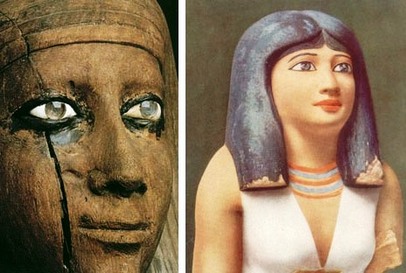
LEFT: King Hor (1783-1633 BC), with gleaming blue-grey eyes; and an Egyptian noblewoman with dark hair and pale complexion. A red-haired corpse was found dating from the predynastic period, 3,300 BC, nicknamed "Ginger." (Here for more.) |
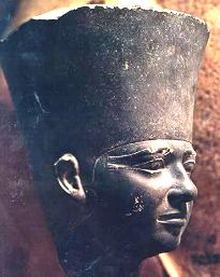
Pharaoh Userkaf (2465-2458 BCE) was an important king of the 5th Dynasty. His title was "His Soul is Strong" His features are distinctly Caucasian. Notably, Userkaf was the first king of Egypt to begin the building of solar temples to the god Ra, The most striking are at Saqqara and Abu Sir. Userkaf's origins are considered uncertain. He may have been the son of the high priest of Memphis or even of Heliopolis where some of the grandest solar temples stood. Egyptian artwork and sculpture reached a peak during his regency.
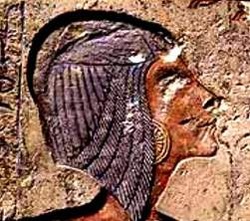
Queen Kiya of the 18th Dynasty. Wife of Akhenaton, and possibly of Pharaoh Heremheb, her thin lips and aquiline appearance suggest she was Caucasian. Probably because of her obvious Western looks, Kiya's ancestry is officially considered a mystery.
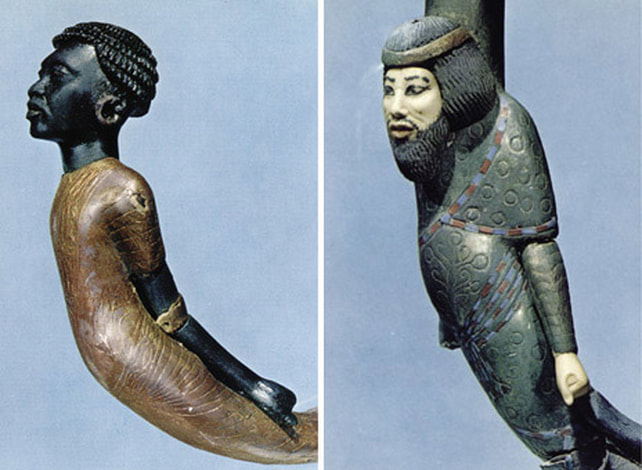
The Egyptians could recognize and depict negroid features as well as we can today. Here we clearly see, from Tutankhamen's own tomb, walking sticks featuring likenesses of conquered enemies of the land. These are so-called "Prisoner Canes" depicting foreign races subjugated by the Egyptians. The enemy has been "taken in hand," so to speak. Notice the Black and Asiatic features of the figures. Similar images are found on the Pharaoh's sandals. Egypt's nobility are not depicted like this. The evidence against "Afrocentrism" is indisputable to rational unbiased observers.
To this very day Christians end prayers with the word Amen. This word is Egyptian for sure, and refers to ancient sun god Amen Ra, worshiped at Thebes. Interestingly, however, the word Amen (from Amentet) meant "Western" or "Western side."
It also refers to the "shadow land" or "underworld," that is, to the realms of the dead. This symbolism arose not only from the fact that the sun perceptibly sank into darkness in the West but from the racial memories of what had occurred in the North-Western lands that had once been veritable wastelands of death and decay. So the very name of the chief solar god of Egypt actually signified ancestral lands of the Western hemisphere.
It also refers to the "shadow land" or "underworld," that is, to the realms of the dead. This symbolism arose not only from the fact that the sun perceptibly sank into darkness in the West but from the racial memories of what had occurred in the North-Western lands that had once been veritable wastelands of death and decay. So the very name of the chief solar god of Egypt actually signified ancestral lands of the Western hemisphere.
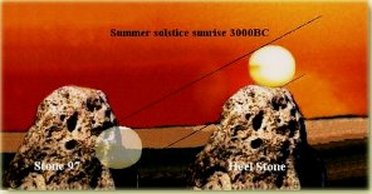
The hieroglyphic for Amen was a straight vertical pole (like the capital letter "I") topped with a small sun disk with rays. This revealing hieroglyphic of Amen was also known as men, meaning "monument," "mountain," or simply "block of stone" or "obelisk."
I suggest that this glyph referred to the ancestral homelands in the West that housed the great and distinctive megalithic temples of stone that stood vertically in the manner described by the Egyptian Amen hieroglyphic. As scholars of Celtic history will be quick to discern, the image of the sun rising above a tall ithyphallic stone perfectly describes the spectacle occurring to this day at many solar temples in England and Ireland, specifically at Stonehenge and Newgrange.
At Stonehenge the sun rises above the famous "heel" stone. The word heel comes from hele or helios, meaning sun. The hieroglyphic expressed that Amen, the sun-god, his priesthood and worship originated in Western lands. That these lands were the "end place," where the sun god rested every evening was the reason why prayers ended with the word Amen, to signify termination. One of the words for prayer was "orison," that clearly resembles "horizon." Again, the reference is to both geography and Astro-Theology.
That the Amen hieroglyphic should connote the ancient Megalithic sun temples of England and Ireland is not so strange once it is realized that Stonehenge and other important British sites have conclusively been shown to be geometrically and geomantically aligned to the Great Pyramid at Giza. We surmise that certain prime Megalithic sites of Britain are also aligned with Egyptian temples, and that the secret theosophy of Irish Druidism was central to the theology of the Theban Amenists, as well as to the sun priests of Lower Egypt. The Egyptians simply duplicated the solar symbolism and geometric principles of the Western Megaliths with their great pyramid. Amen, the sun, rose above their "mountain" of stone at Giza in the same way as it did in the original Western homelands of Amen. (Here for more.)
I suggest that this glyph referred to the ancestral homelands in the West that housed the great and distinctive megalithic temples of stone that stood vertically in the manner described by the Egyptian Amen hieroglyphic. As scholars of Celtic history will be quick to discern, the image of the sun rising above a tall ithyphallic stone perfectly describes the spectacle occurring to this day at many solar temples in England and Ireland, specifically at Stonehenge and Newgrange.
At Stonehenge the sun rises above the famous "heel" stone. The word heel comes from hele or helios, meaning sun. The hieroglyphic expressed that Amen, the sun-god, his priesthood and worship originated in Western lands. That these lands were the "end place," where the sun god rested every evening was the reason why prayers ended with the word Amen, to signify termination. One of the words for prayer was "orison," that clearly resembles "horizon." Again, the reference is to both geography and Astro-Theology.
That the Amen hieroglyphic should connote the ancient Megalithic sun temples of England and Ireland is not so strange once it is realized that Stonehenge and other important British sites have conclusively been shown to be geometrically and geomantically aligned to the Great Pyramid at Giza. We surmise that certain prime Megalithic sites of Britain are also aligned with Egyptian temples, and that the secret theosophy of Irish Druidism was central to the theology of the Theban Amenists, as well as to the sun priests of Lower Egypt. The Egyptians simply duplicated the solar symbolism and geometric principles of the Western Megaliths with their great pyramid. Amen, the sun, rose above their "mountain" of stone at Giza in the same way as it did in the original Western homelands of Amen. (Here for more.)
Osiris sails through the underworld on his solar boat. He was the god of earth and the dead. He represented the natural cycles of birth and death. His "dismemberment" recalled the cataclysms and paroxysms that visited the world, and which were particularly devastating to the North-Western Hemisphere. The root of his name, sir, meant the "West." Indeed, one name for Osiris was Wesir, which is remarkably similar to the present spelling of West. It is my belief that the entire cult of Osiris was transported to Egypt from Britain. Wesir (Osiris) is known to have replaced Khentamentiu whose name meant "Foremost of the Westerners." As Isis (Ast) represented the East, so did her husband (Asir) represent the West. Scholars accept without question that the Greeks and Romans fused several deities together to form individual members of their own pantheons. Serapis, Dionysus, Mithras, and even Zeus, were composites of archaic Egyptian and Sumerian gods. The Egyptians were not above the same plagiarization. Many of their gods and goddesses were fusions of more ancient figures. This is particularly true of Hathor, Ptah, Osiris, and Horus. Scholars readily accept that the Greeks and Romans borrowed their gods from Egypt. They are, however, not as receptive to the idea that the Egyptians had done something similar. The Western origins of Egyptian cultural elements is not to be broached or considered. Osiris on his boat gives us the visual impression that this god was indeed from beyond the sea, He frequented the "Underworld" and that was not, as we are meant to believe, merely a conceptual realm. It was a physical region. It was the ancestral lands of the North-West ruined by natural upheaval. It was the land of the setting sun, of darkness and death, into which the sun (Osiris) retired (or returned) at day's end.
The enemy of Osiris and his son Horus was the serpentine Typhon. This is where we get the word Typhoon. The serpentine deity Typhon or Apophis was a mythographic adversary representing the destructive force of nature. Osiris traveled West every night to sacrificially enter into combat with the evil serpent and ensure that such incomprehensible cataclysm should never reoccur. This fact is further reinforced when we remember that the main symbol of Osiris was the Djed Pillar. The fallen column is shown being ritually reset in its vertical position. This rite of lifting the pillar of Osiris into upright position encapsulated the same idea of which we speak. It represented the restoration of order and stability after a time of worldwide calamity. (See the chapter on Comyns Beaumont for more on this subject.) Osiris was associated, and even fused, with Old Kingdom god Seker or Sokar. Seker was depicted as a mummified deity, falcon or hawk-headed, with green skin representing rebirth. Of course, this green coloring parallels the Irish Herne or Cernunnos, god of nature. Seker was often shown hovering on wings above the body of the deceased. He was, therefore, the basis of the Christian Holy Spirit.
The enemy of Osiris and his son Horus was the serpentine Typhon. This is where we get the word Typhoon. The serpentine deity Typhon or Apophis was a mythographic adversary representing the destructive force of nature. Osiris traveled West every night to sacrificially enter into combat with the evil serpent and ensure that such incomprehensible cataclysm should never reoccur. This fact is further reinforced when we remember that the main symbol of Osiris was the Djed Pillar. The fallen column is shown being ritually reset in its vertical position. This rite of lifting the pillar of Osiris into upright position encapsulated the same idea of which we speak. It represented the restoration of order and stability after a time of worldwide calamity. (See the chapter on Comyns Beaumont for more on this subject.) Osiris was associated, and even fused, with Old Kingdom god Seker or Sokar. Seker was depicted as a mummified deity, falcon or hawk-headed, with green skin representing rebirth. Of course, this green coloring parallels the Irish Herne or Cernunnos, god of nature. Seker was often shown hovering on wings above the body of the deceased. He was, therefore, the basis of the Christian Holy Spirit.
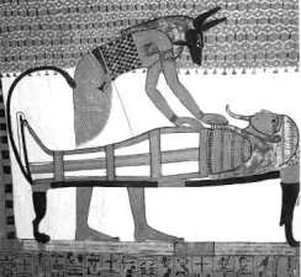
Anubis was one of the oldest gods of Egypt and closely associated with Osiris and Horus. Some traditions have him as the brother of Horus and son of Nephthys the sister of Isis. He was largely based on the most ancient Jackal-headed god known as Khenta-Mentiu, worshiped in Upper Egyptian cities such as Abydos and Saqqara. Suggestively, this name means "Foremost of the Westerners." Mentiu or Mentu was a hawk-headed god thought to have been the early precursor of Horus. His title was the "Nomad," which implies a distant god of foreign origin. We conclude that many of Egypt's predynastic gods had Western origins. Egyptians understood this Anubis as lord of the Western lands and hemisphere. This also meant he was the ruler of the dead. Egyptians associated the Underworld with the lands beyond the Western horizon ("Zone of Horus"), not only because the sun set there but because of the terrible ruin that had been suffered by the lands of the North-West.
Those who still find it impossible or far-fetched to suppose that Egyptian religion and culture was influenced by foreigners from Western lands, should bear in mind that historians already accept that Western Indo-Europeans contributed cultural elements to Northern India. They should bear in mind that the Moslems of Persia and Yemen brought to India highly sophisticated cultural elements as they established their Mughal dynasty, and that Buddhism, born in India, moved Eastward to dramatically influence and enrich Chinese culture. They had best remember the fact that during the early centuries of the Christian era, up until the Middle Ages, Culdean monks traveled throughout Europe from Ireland in their capacity as educators of nobility. Yes, Marco Polo could travel to China, as all agree he did. Abaris could make his way from Ireland to the Athenian school of Pythagoras, and Apollonius of Tyana could travel to India to locate the schools and ashrams of the Brahmins. Ancient Irishmen could travel Eastward and settle in Scotland, giving that country its distinctive name. Such cases are not doubted. But speak of traversal in the opposite direction and one is met with a wall of resistance.
It has taken centuries for academics to begrudgingly entertain this simple idea although ultimately it is still tantamount to academic heresy to pronounce Egypt to be the cradle of civilization and originator of Christian theology. Nonetheless, academics will sooner muse over and ratify commerce from East to West than endorse traversal from West to East. Indeed, this rarer kind of speculation, first asserted by Comyns Beaumont, Anna Wilkes, Ignatius Donnelly and Conor Mac Dari, is quite taboo.
Nevertheless, the reason why members of the Egyptian nobility were interned in Ireland is simply because Ireland was an ancestral homeland to which they were returning.
It was from the British Isles that their forefathers had come bearing the knowledge that enabled Egypt's fine civilization to form. It was Western science that brought about the construction of the Great Pyramid and Sphinx. No other race was responsible for their construction.
The world endures a mystery concerning their origins because the true architects have been forced into the shadows of history.
It has taken centuries for academics to begrudgingly entertain this simple idea although ultimately it is still tantamount to academic heresy to pronounce Egypt to be the cradle of civilization and originator of Christian theology. Nonetheless, academics will sooner muse over and ratify commerce from East to West than endorse traversal from West to East. Indeed, this rarer kind of speculation, first asserted by Comyns Beaumont, Anna Wilkes, Ignatius Donnelly and Conor Mac Dari, is quite taboo.
Nevertheless, the reason why members of the Egyptian nobility were interned in Ireland is simply because Ireland was an ancestral homeland to which they were returning.
It was from the British Isles that their forefathers had come bearing the knowledge that enabled Egypt's fine civilization to form. It was Western science that brought about the construction of the Great Pyramid and Sphinx. No other race was responsible for their construction.
The world endures a mystery concerning their origins because the true architects have been forced into the shadows of history.
|
The Druidical religion prevailed not only in Britain, but likewise all over the East - Edward Vaughan Kenealy (Book of God)
|
